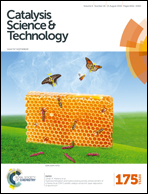TiO2@h-CeO2: a composite yolk–shell microsphere with enhanced photodegradation activity†
Abstract
In this paper, a composite yolk–shell microsphere (TiO2@h-CeO2) with TiO2 as a core and CeO2 as a shell was successfully synthesised. The intermittent SiO2 layer protective method was carried out to protect the microstructure and crystalline phase of TiO2@h-CeO2 during calcination. The morphology, chemical composition, and optical properties of TiO2@h-CeO2 were confirmed by systematic characterization techniques, including SEM, HRTEM, XRD, Raman spectroscopy, FT-IR and UV-vis DRS. The effect of the SiO2 protective method on the crystallisation temperature was also examined. The catalytic activity of TiO2@h-CeO2 was evaluated by photodegradation of methylene blue. As compared with the anatase sphere, hollow-CeO2 (h-CeO2), and mixture of an anatase sphere & h-CeO2, TiO2@h-CeO2 exhibited an enhanced photocatalytic efficiency. It is hypothesised that hydrophilia of the CeO2 shell, as compared to the anatase sphere, would adsorb more water, and the contribution of both CeO2 and TiO2 would improve the generation of photo-produced holes. Hence, it is beneficial to combine absorbed water and holes to form hydroxyl radicals. Further evidence for improvement in photocatalytic activity was also established.


 Please wait while we load your content...
Please wait while we load your content...